calsfoundation@cals.org
Empress [Steamboat]
The Empress was a steamboat built in 1861 and frequently used by Union forces in the western waters during the Civil War. The vessel survived a devastating Confederate attack in Chicot County in August 1864 only to hit a snag and sink a few months later.
Alex Temple, “a good builder,” constructed the Empress at Madison, Indiana, for a Captain Gould in 1861. The 854-ton sidewheel paddleboat was 265 feet long and forty-one feet wide with a hold of eight feet and three inches. The vessel had four high-pressure boilers that powered two engines, “each 26 inches in diameter, with 10 feet stroke.” A St. Louis, Missouri, newspaper in March 1861 proclaimed Empress “a very staunch, compact boat, built expressly for the carrying trade between St. Louis and New Orleans.”
In a May 1861 incident during the Civil War, the Empress was passing a camp of around 400 Tennessee state troops about six miles above Memphis when a cannon shot was fired across its bow. When the vessel stopped, some of the soldiers “very cooly took possession of a hogshead of sugar…and rolled it ashore, giving as an excuse that they needed it.” The following March, the Empress was boarded by a slave hunter and an owner seeking a dozen enslaved men who had been smuggled aboard by the men of Colonel Josiah W. Bissell’s regiment of Union engineers. They received a warrant to search the boat, during which “they were subject to the scoffs and jeers of the whole regiment,” but found only one man; “the other contrabands were doubtless moved around by the soldiers…and will probably effect their escape with the regiment.”
In mid-April 1862, the Empress was sent to Pittsburg Landing on the Tennessee River with members of the U.S. Sanitary Commission, who had designated it a hospital boat as Union forces dealt with the large number of casualties from the battle of Shiloh. After emptying its cargo of cattle, horses, and forage, the Empress took on 352 wounded men, “besides a number of wounded officers, occupying state rooms,” and transported them to medical facilities at Savannah, Tennessee. The vessel also served as the headquarters of the Union army’s Third Division in the December 1862 Yazoo Pass Expedition in Mississippi.
While the Empress continued pursuing private business, it was always subject to military demands. Noting that “steamboat agents propose and Government agents dispose,” a correspondent to a St. Louis newspaper reported a September 24, 1863, incident in which the Empress and several other steamers were “impressed into Government service as transports, and forthwith they commenced discharging of the freight &c., they had taken on board….These boat seizures are annoying but in war times such are to be expected.”
Nevertheless, the Empress arrived in New Orleans from Natchez, Mississippi, about a month later carrying 4,901 bales of cotton, “the largest load brought to this port since the present unhappy state of affairs.” After paying $20,000 in expenses and repairs, the Empress “showed a clear profit of $127,000” for the year 1863.
The Empress was impressed into government service from November 6 to December 2, 1863, and chartered by the U.S. government for February 9–21 and May 2–8, 1864. Captain John Molloy, a forty-year-old Irishman, took command of the steamboat in June 1864.
On August 10, 1864, the Empress was passing Gaines’ Landing (Chicot County) when Brigadier General John Sappington Marmaduke’s Confederates opened a furious barrage of cannon and rifle fire, seriously damaging the vessel, which was eventually towed to safety by the tinclad USS Romeo. Molloy was decapitated, four other men were killed, and at least twelve were wounded in the attack on the unarmed steamboat.
After undergoing $28,000 in repairs, the Empress was soon back in business and “considered second to no boat on the western waters.” The steamer was passing Island 34 on the Mississippi River with a load of flour, grain, and cattle and carrying around 200 primarily military passengers when it struck a snag around 8 a.m. on October 30, 1864. After drifting a short distance, the Empress sank in ten feet of water; “the passengers rushed to the upper decks but very little excitement prevailed,” and no one was injured. The steamboat Dunleith took the passengers aboard. The “boat and cargo will prove a total loss.”
For additional information:
“By Telegraph.” New Orleans Times, November 4, 1864, p. 2.
“From New Orleans.” [St. Louis] Daily Missouri Republican, October 13, 1863, p. 1.
“The Empress.” Daily Missouri Republican, March 18, 1861, p. 3.
“The Empress a Hospital.” [St. Louis] Daily Missouri Republican, April 19, 1862, p. 2.
“Full Details of the Attack on the Steamer Empress.” Daily True Delta, August 16, 1864, p. 1.
“Full Particulars of the Attack on the Steamer Empress.” New Orleans Times, August 16, 1864, p. 2.
“A Good Year’s Work.” [New Orleans] Daily True Delta, April 26, 1864, p. 4.
“Latest by Telegraph.” Kansas City [Missouri] Journal, May 16, 1861, p. 2.
“River Intelligence.” New Orleans Times, June 28, 1864, p. 8.
“River Intelligence.” New Orleans Times, October 22, 1863, p. 4.
“Runaway Negroes on the Steamer Empress—Process of Civil Law Resisted.” [St. Louis] Daily Missouri Republican, March 4, 1862, p. 3.
Gibson, Charles Dana, and E. Kay Gibson, comps. Dictionary of Transports and Combatant Vessels Steam and Sail Employed by the Union Army, 1861–1868. Camden, ME: Ensign Press, 1995, p. 105.
Way, Frederick, Jr. Way’s Packet Directory. Athens: Ohio University Press, 1983, p. 152.
Mark K. Christ
Central Arkansas Library System
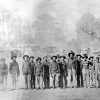 Civil War through Reconstruction, 1861 through 1874
Civil War through Reconstruction, 1861 through 1874 Military
Military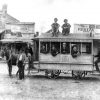 Transportation
Transportation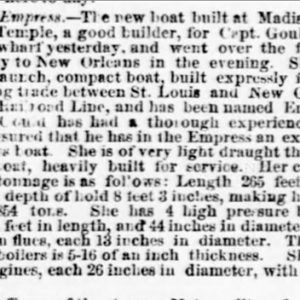 Steamboat Empress Article
Steamboat Empress Article  Empress Sinking Article
Empress Sinking Article  Empress Article
Empress Article 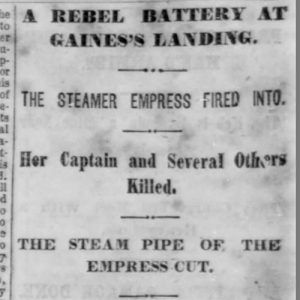 Empress Attack Article
Empress Attack Article 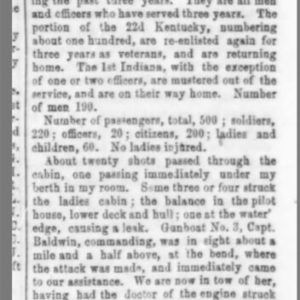 Empress Attack Article
Empress Attack Article 



Comments
No comments on this entry yet.